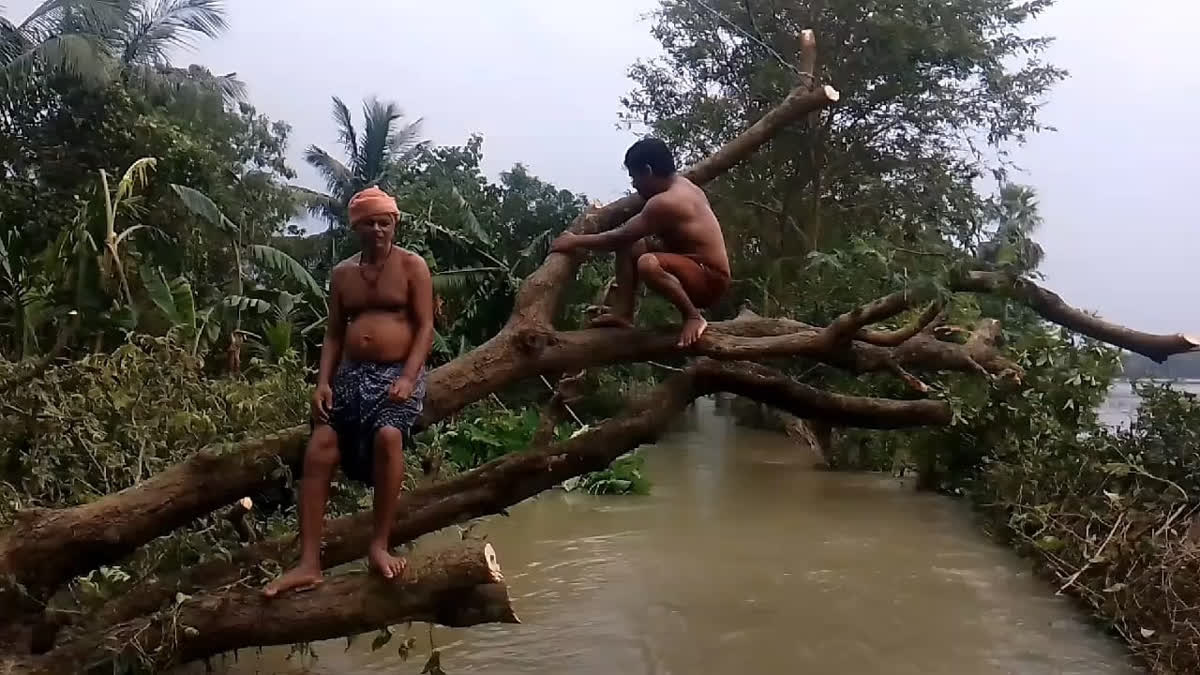Bhubaneswar/Balasore: Following the devastating storm that struck coastal Odisha, the impact has been most severe in five blocks, particularly within the Balasore district. District authorities have begun a thorough assessment of the damage, but many regions, including Soro and Khaira blocks, remain without electricity. In the aftermath, residents in low-lying areas struggle as floodwaters have engulfed entire villages under Baranagar Panchayat - Sunari, Astabanka, Salampur, Ankurkharji, ChauliSabira, Padanpada, Rahania, Dihi Sabira, Bilsabira, and Brahman Sabira under water. This waterlogging has resulted from the rising Kansabansa River. However, from Monday morning, flood waters have started receding.
Discussing the restoration work, District Magistrate Suryavanshi Mayur Vikas said, “Recovery efforts are underway in the five worst-hit blocks. We’ve cleared fallen trees and debris from main roads, and water drainage is in progress.” He added that teams from various blocks have been mobilized to expedite recovery, with the goal of completing major rehabilitation tasks by November 2.
To address the immediate needs of affected residents, authorities have prioritized essential services for livestock, distributing fodder where needed. Free kitchen services are now limited to the most impacted zones as people gradually return to their homes. Floodwaters are also receding in surrounding districts as rainfall decreases, the collector added.
Support teams, including ODRAF, NDRF, and fire department personnel, are actively engaged in relief and restoration efforts, ensuring that even the most remote and flood-stricken communities receive necessary services and support.
After an aerial survey on Sunday, Chief Minister Mohan Charan Majhi announced that 92% of homes affected by Cyclone Dana have had their power restored. However, post-cyclone flooding has created a new crisis, particularly in Balasore and Mayurbhanj districts, where rising waters in the Budhabalanga River have forced the relocation of residents. To manage the flood threat, 21 additional power boats have been deployed to these districts.
Majhi had said that 10,500 residents of Balasore have been moved to safer areas. “With continued cooperation, we are handling the situation effectively,” he assured, noting that electricity is expected to be fully restored by Sunday night.
The CM is also likely to go on an aerial visit to the flood affected areas on Monday.
In Balasore district, standing crops in almost all areas have been wiped off putting farmers in a quandary. Naik said, “Thanks to cooperative efforts, the situation is under control with no accidents reported. Electricity restoration is underway, and waterlogged areas are being monitored. Residents with damaged homes are urged to report within seven days to receive assistance. Road repairs will also be prioritized.”
Providing an initial assessment, District Collector said extensive damage has been done with trees uprooted in Khaira, Simulia, Bahanaga, and Nilagiri. “Around 40,000 to 45,000 families faced disconnection, but 20,000 have been reconnected. Efforts are on with Tata Power officials aiding restoration. We’re clearing blocked roads and expect power and road access to be restored by evening,” he stated.
Flooding during Cyclone Fani in Odisha in May 2019:
The cyclone caused a storm surge of up to 1.5 meters in height, which flooded low-lying areas in the districts of Ganjam, Khurda, Puri, and Jagatsinghpur. At least 36 villages were flooded and 2,000 homes destroyed. Winds of up to 200 km/h (125 mph) blew off roofs, damaged power lines, and uprooted trees. Summer crops, orchards, and plantations were devastated. Cyclone Fani was one of the worst cyclones to hit India in the last two decades. It affected over 1.51 crore people in 16,659 villages.
Cyclone Titli impact on Odisha in October 2018:
Along its path, Titli damaged 127,081 houses, forcing 63,562 people to stay in relief camps. Floodwaters entered the jail in Aska. Two major rivers, the Rushikulya and the Vamsadhara, swelled to reach dangerous levels, causing flooding in three districts that affected more than 600,000 people in the districts of Ganjam, Gajapati, and Rayagada. The water levels in major rivers like the Rushikulya and Bansadhara crossed the danger mark. The Jalaka river in Balasore flowed six meters above the danger level. The floods damaged over 3,785 square kilometers of crops and killed many farm animals.
The 1999 Super Cyclone in Odisha
The cyclone's storm surge traveled up to 20.1 kilometers inland, causing massive tidal waves that submerged coastal areas. Its slow movement and re-curving track caused heavy rainfall, averaging around 600 millimeters in 6 days. It caused rivers to breach 20,005 flood embankments, flooding villages, cities, and farmlands. The cyclone destroyed or damaged around 1.6 million homes, 13 lakh hectares of paddy crop, 1.76 lakh hectares of vegetables, and 2.57 lakh hectares of other crops. The cyclone also destroyed 22,143 fishing nets and 9,085 boats.
Post landfall in Jagatsinghpur district on October 29, 1999, the Paradip and Erasama blocks suffered the worst damage. The cyclone killed nearly 10,000 people, with Jagatsinghpur alone accounting for 8,119 fatalities.



